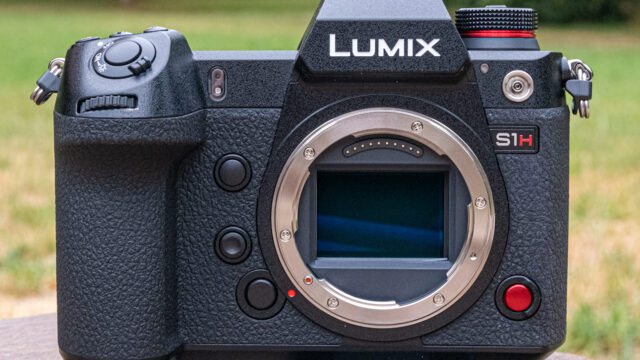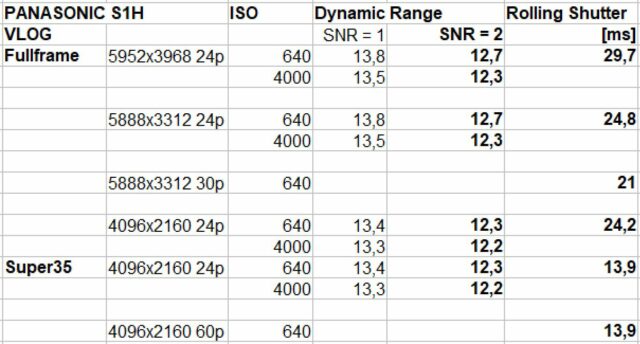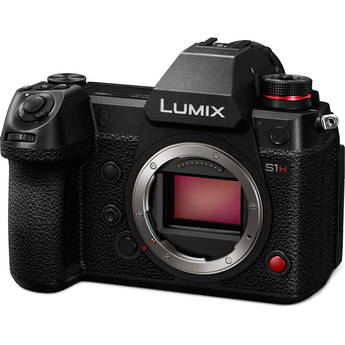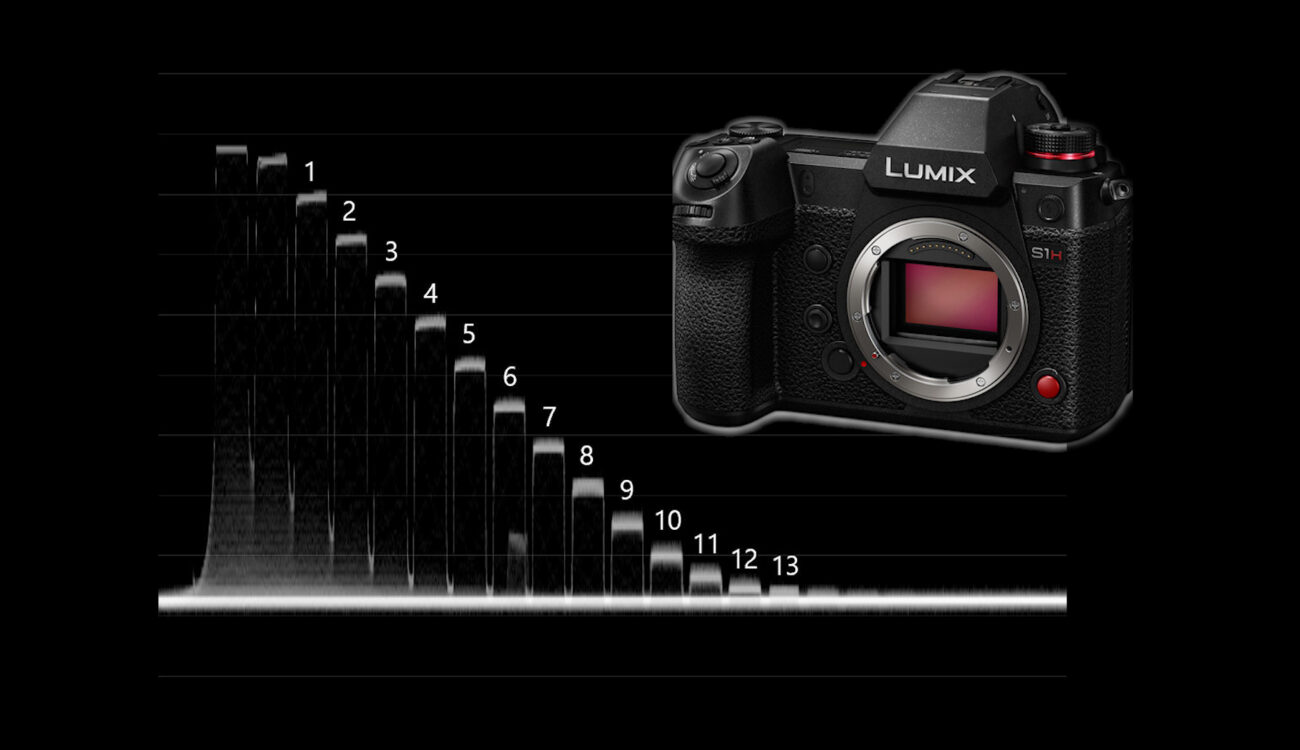
Finally, we were able to put the Panasonic S1H to the test in our cinema5D lab. Looking at the various frame rates and resolutions, as well as the full frame and Super 35 modes of this camera, this turned out to be quite an endeavour. Ready for a lab marathon? Read on…
I have long waited for the day to come when I would be able to put the Panasonic S1H through our lab test procedures. I sold my Sony a7S II a while ago expecting a successor to be announced soon, now finding myself impatient in the waiting position for my next camera purchase … will this cam be it?
Spoiler alert: lab results are very impressive – the Panasonic S1H is the first camera in our tests, that shows nearly identical dynamic range results for the two ISO settings of the dual gain sensor! I will share most of the results in detail with you, so this is going to be a long read. Sorry about that…
As described by my colleagues Nino, Jeff, and Johnnie in detail here, the Panasonic S1H is designed with a “video first” mindset by Panasonic and ticks a lot of my personal boxes. I was even hoping for an internal ProRes recording option, but dream on my friends (just to be clear, Panasonic and Atomos are working together in delivering 5.9K ProRes RAW data output to Atomos Ninja V recorder. More info can be found here).
Nevertheless, the specs are impressive as is the price – so will it live up to the high expectations?
To help you read through this post, it is organized as follows:
- ISO640 V-Log dynamic range results for 6K, 5.9K, and 4K DCI full frame
- ISO4000 V-Log dynamic range results for 6K, 5.9K, and 4K DCI full frame
- Rolling shutter results for 6K, 5.9K, and 4K DCI full frame as well as Super 35
- Summary table of all measurements
So let’s dive into the results.
Dynamic Range Measurement of the Panasonic S1H
If you are not familiar with how we test dynamic range in our lab, have a look here first.
As mentioned at the beginning of the article, the list of resolutions/codecs/ frame rates/crop options on the Panasonic S1H is endless, and bearing in mind the fact that this camera offers two native ISO’s (640 and 4000 in V-Log), I had to focus at these key areas: 6K 3:2, 5.9K 16:9, 4K DCI full frame and Super 35 in 24p, 30p and 60p.
ISO 640 V-Log 6K 3:2 Mode (5952×3968) and 5.9K 16:9 Mode (5888×3312) Dynamic Range Results:
First positive surprise: in 6K 3:2 mode (5952×3968) and 5.9K 16:9 mode (5888×3312) the dynamic range measured by IMATEST at a signal to noise ratio (SNR) of 2 is 12.7 stops! This is the second-best result that we have ever measured, right after the ARRI Alexa (14 stops at SNR=2).
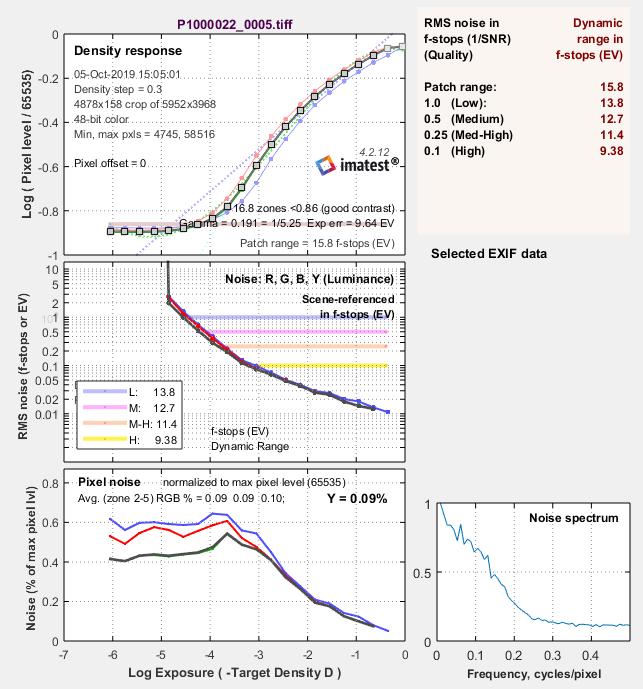
IMATEST dynamic range result Panasonic S1H in 5952×3968 (full frame 3:2 mode) V-Log ISO640. 12.7 stops are calculated for SNR = 2
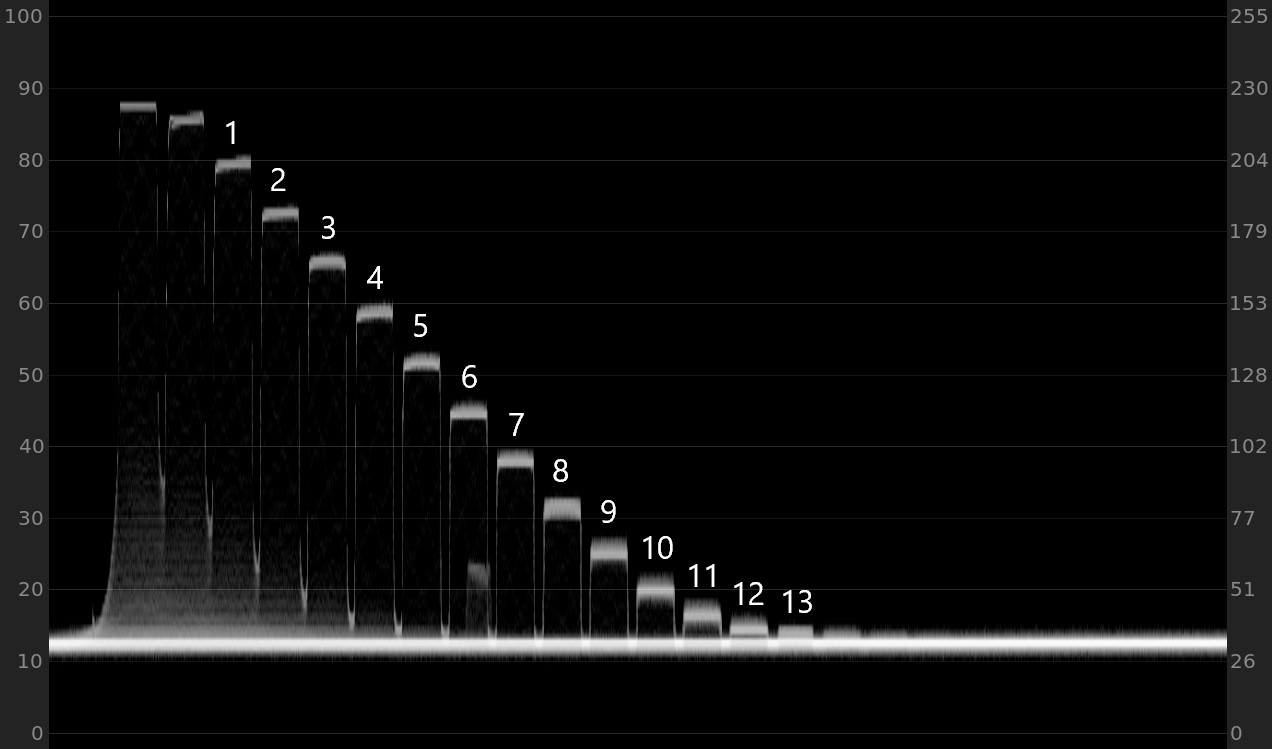
Waveform plot of the Xyla 21 step chart Panasonic S1H 5952×3968 Full frame V-Log ISO640 – about 13 stops can be identified above the noise floor.
Looking at the waveform plot of the step chart the IMATEST result is confirmed – about 13 stops above the noise floor can be identified, see the plot above. As a video codec, H265 10bit 4:2:0 (HEVC) at around 200Mbit/s is the default for the 6K 3:2 and 5.9K 16:9 modes (I measured around 180Mbit/s for the step chart video files).
ISO 640 V-Log 4K DCI (4096×2160) Full Frame Dynamic Range Results:
Next up is 4K DCI (4096×2160) in full frame mode. Quite interestingly the dynamic range drops to 12.3 stops. This comes unexpectedly, as I was assuming that the 6K sensor width would be scaled to 4K hence the noise and therefore dynamic range should slightly improve.
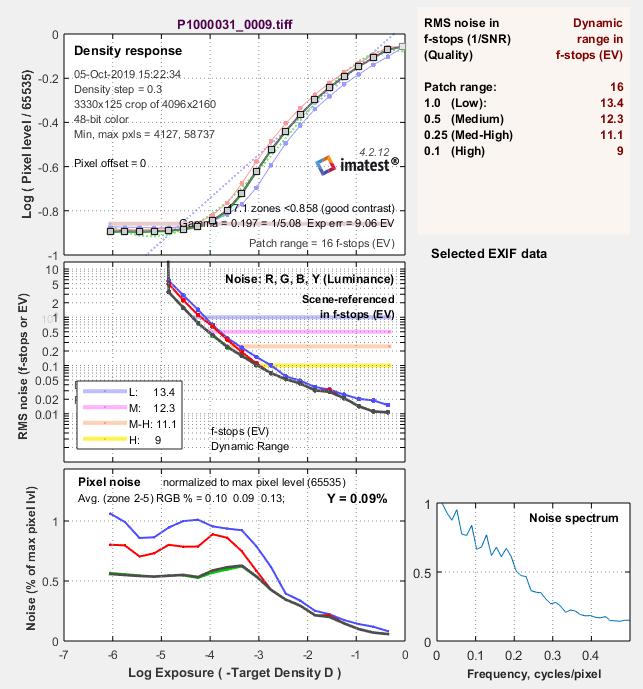
IMATEST dynamic range result Panasonic S1H 4096×2160 Full frame V-Log ISO640. 12.3 stops are calculated for SNR = 2
Looking at the noise results in IMATEST (lowest graph of the three in the image above) and waveform plot for 4K DCI full frame mode below, it becomes obvious that the noise floor is more pronounced – simply more noise is present.
A major difference to 6K and 5.9K is the used codec: H264 10bit 4:2:2 is the setting for 4K DCI, and the step chart video files showed about 420 Mbit/s bitrate.
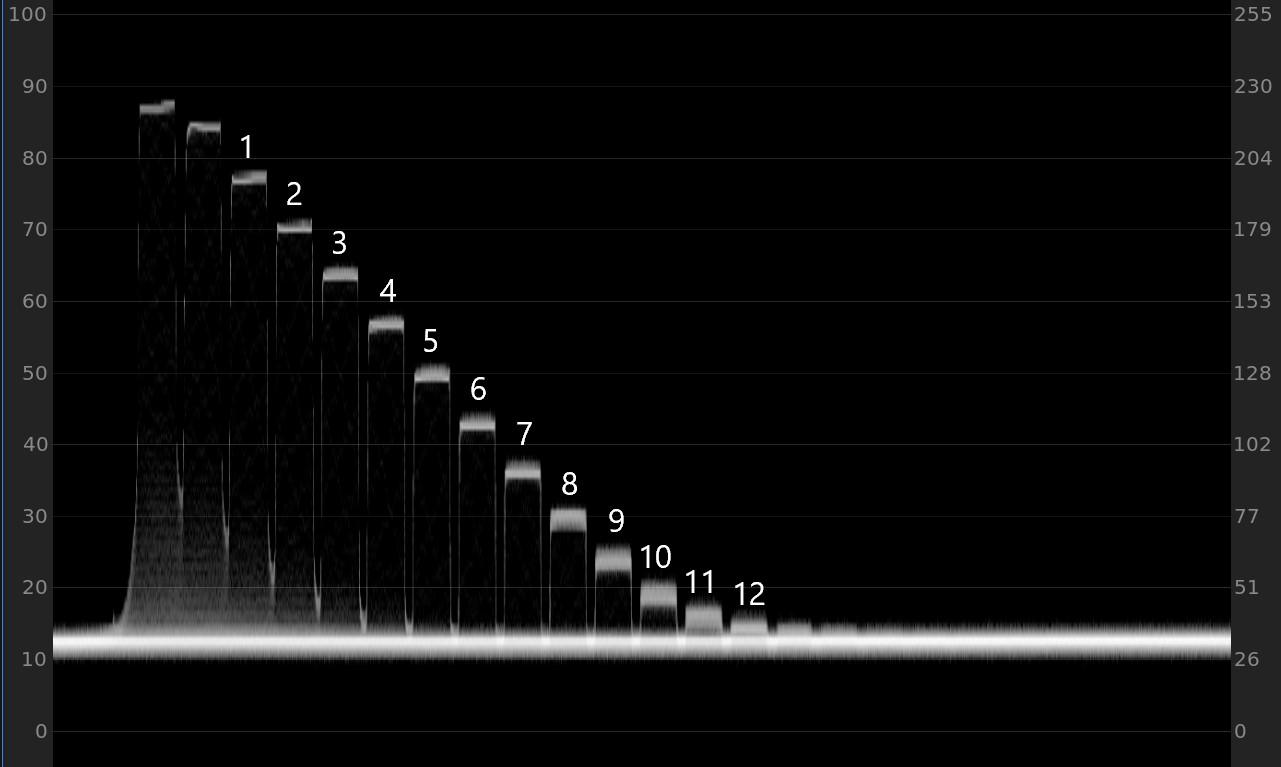
Waveform plot of the Xyla 21 step chart Panasonic S1H at 4K DCI Full frame V-Loog ISO640 showing 12 stops above the noise floor.
Now we are left to speculate what is happening here – why are we getting 0.4 stops less?
First, in 6K and 5.9K, the measured H265 bitrate of about 180Mbit/s is low for 10bit 6K. If we compare 5.9K 16:9 (19.5 Megapixel) to 4K DCI (8.8 Megapixel) we have about 2.2 times the pixels to encode – it equals to about 80Mbit/s H265 4:2:0 compared to 420Mbit/s H264 4:2:2 for 4K. Is this enough to encode the noise in the lower stops properly? I could not see any macro blocking in the shadows so it does looks robust to my eye.
Second, we can see that the image in 6K and 5.9K at ISO640 is less noisy compared to 4K DCI. Again, pure speculation – but is some sort of internal noise reduction happening here to help encode the image at this low H265 bitrate? Is the full frame 4K DCI image much closer to the “raw” image of the sensor?
Third, the spec sheet mentions a low pass filter that is used to reduce Moiré. Could it be that the 6K image is a bit soft on the pixel level due to the low pass filter, and therefore the noise is blurred to an extent? As will be seen below looking at the ISO4000 results, to an extent (about 0.1 stop) this seems to be true but cannot explain the 0.4 stops difference that we are seeing.
For your info, comparing the Panasonic S1H 4K DCI dynamic range results to the Panasonic S1 UHD results, we are getting almost equal numbers: 12.3 stops for the S1H, 12.2 stops for the S1 at SNR = 2.
Now let’s see what happens if we increase the ISO to the second gain value, namely 4000.
ISO4000 V-Log 6K 3:2 Mode (5952×3968) and 5.9K 16:9 Mode (5888×3312) Dynamic Range Results:
The next surprising result – at ISO4000 we see only a slight drop of 0.4 stops in dynamic range, see the IMATEST result below. While we got 12.7 stops at ISO640, we are now seeing 12.3 stops at ISO4000 for 6K and 5.9K full frame mode.
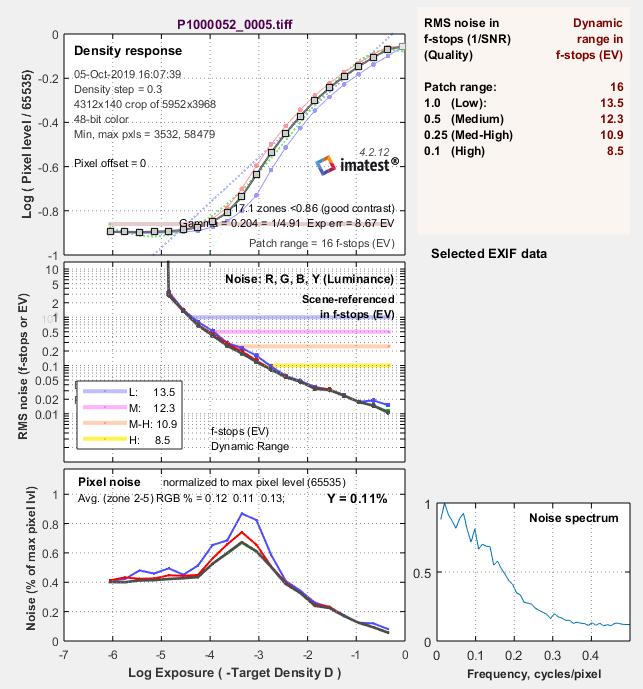
IMATEST dynamic range result Panasonic S1H in 5952×3968 (full frame 3:2 mode) V-Log ISO4000. 12.3 stops are calculated for SNR = 2.
Looking at the waveform below, this result is confirmed. More than 12 stops can be identified at ISO4000 (even the 13th stop looks still quite solid to my eye).
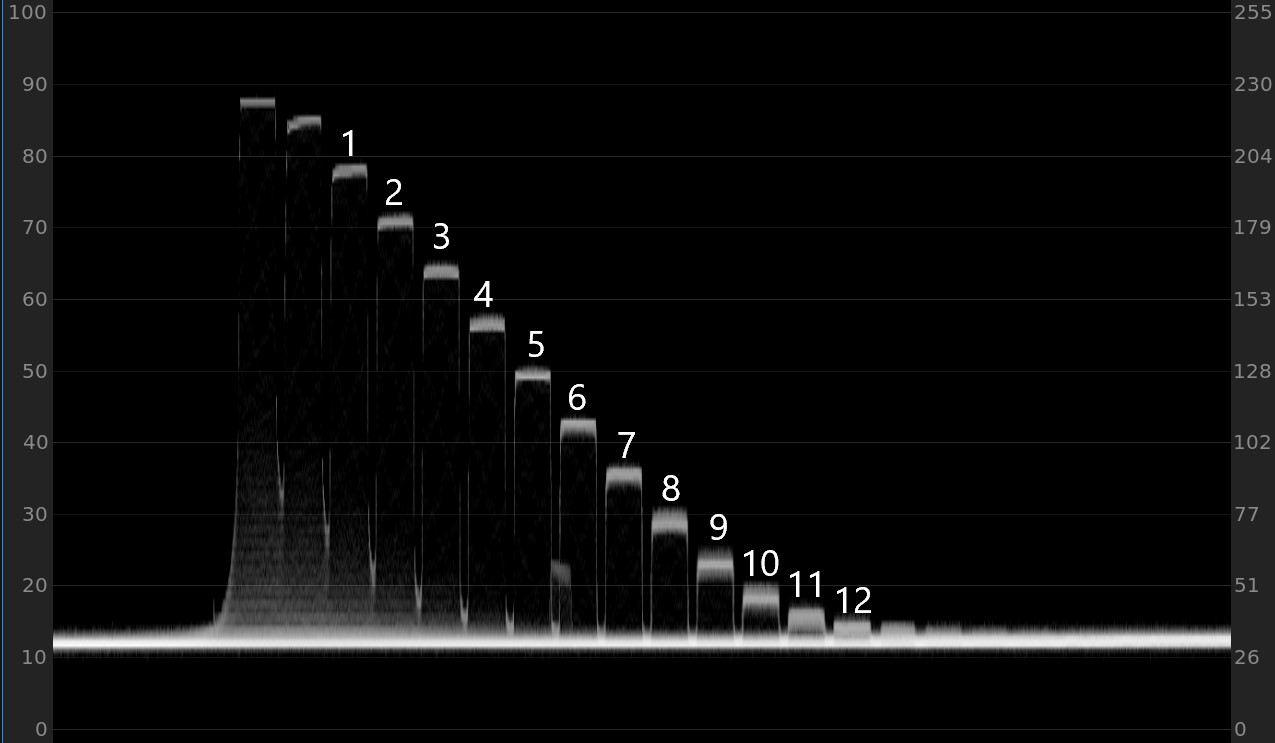
Waveform plot of the Xyla 21 step chart Panasonic S1H 5952×3968 Full frame V-Log ISO4000. More than 12 stops can be identified above the noise floor.
ISO 4000 V-Log 4K DCI (4096×2160) Full frame Dynamic Range Results:
Another surprise – in 4K DCI mode almost the same result as for 6K and 5.9K is now achieved – 12.2 stops. Even more surprising is the fact, that there is almost no difference between ISO640 and ISO4000 in 4K DCI mode – only 0.1 stops of dynamic range are lost switching to the higher ISO value – very impressive!
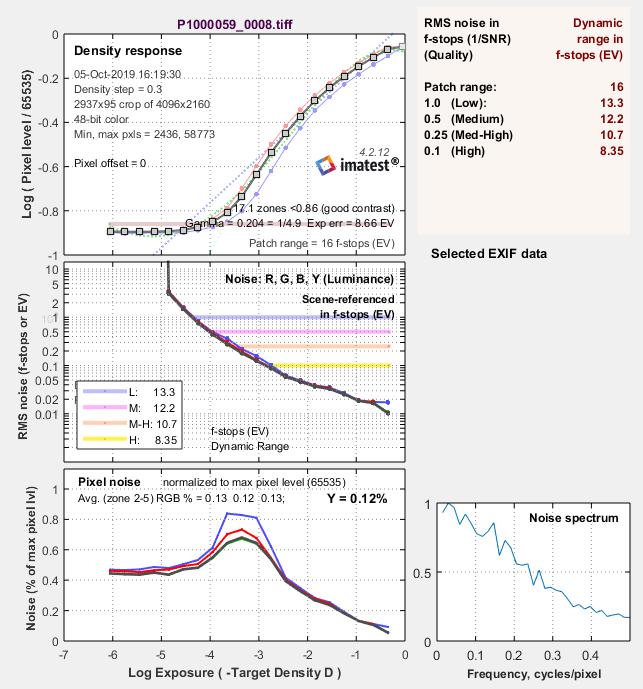
IMATEST dynamic range result Panasonic S1H 4096×2160 Full frame V-Log ISO4000. 12.2 stops are calculated for SNR = 2. Notice that we are getting almost exactly the same result as with ISO 640!
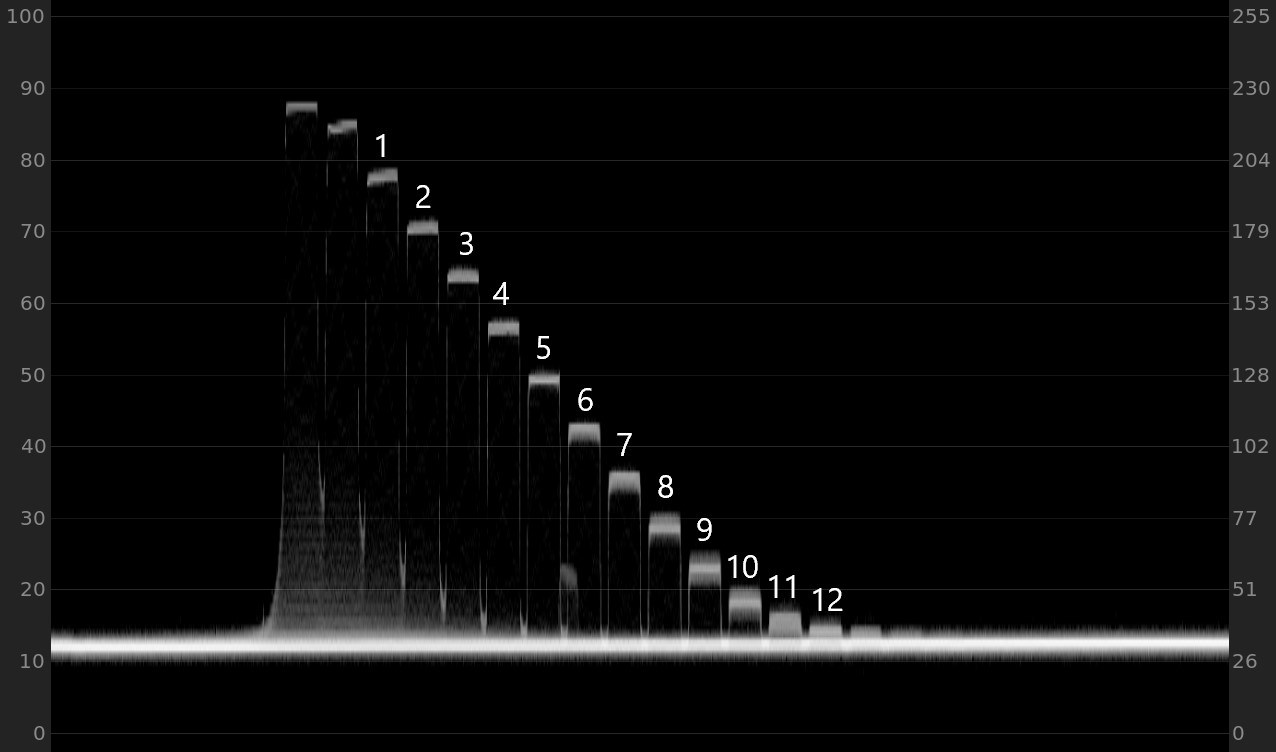
Waveform plot of the Xyla 21 step chart Panasonic S1H at 4K DCI Full frame V-Log ISO4000. 12 stops can be identified above the noise floor.
Another interesting observation: at ISO4000, the 6K and 5.9K V-Log results are now very similar to the 4K DCI full frame results – we see only 0.1 stops difference. Seems that noise reduction (speculation #2 above) is not so present here. The 0.1 stops could be due to the low pass filter blurring some noise on the pixel level (as mentioned earlier, see speculation #3).
Rolling Shutter Measurements of the Panasonic S1H
We are using a strobe light at 300Hz which creates a pattern of black and grey bars due to the nature of read out from top to bottom of CMOS sensors. Each set of black/grey stripes is equal to 3.3 [ms] of rolling shutter.
Let’s start with the worst scenario: the 6K 3:2 mode should have the highest rolling shutter, as all the vertical 3968 pixels from top to bottom have to be captured for each frame. In this mode at 23.98 frames per second, the Panasonic S1H has a rolling shutter of 29.7 [ms].
This is a very high value – the rolling shutter is partially mitigated thanks to the stabilized sensor so handheld shooting is no problem but takes it slow on pans.
For 5.9K 16:9 mode at 23.98fps, a rolling shutter of 24.8 [ms] is measured, for 29.98fps the result is better at 21 [ms]. For a full frame sensor, those values are average. Looking at the 23.98 fps result, the Panasonic S1 was a tad better – at 25fps a value of 22 [ms] capturing UHD was measured for the S1.
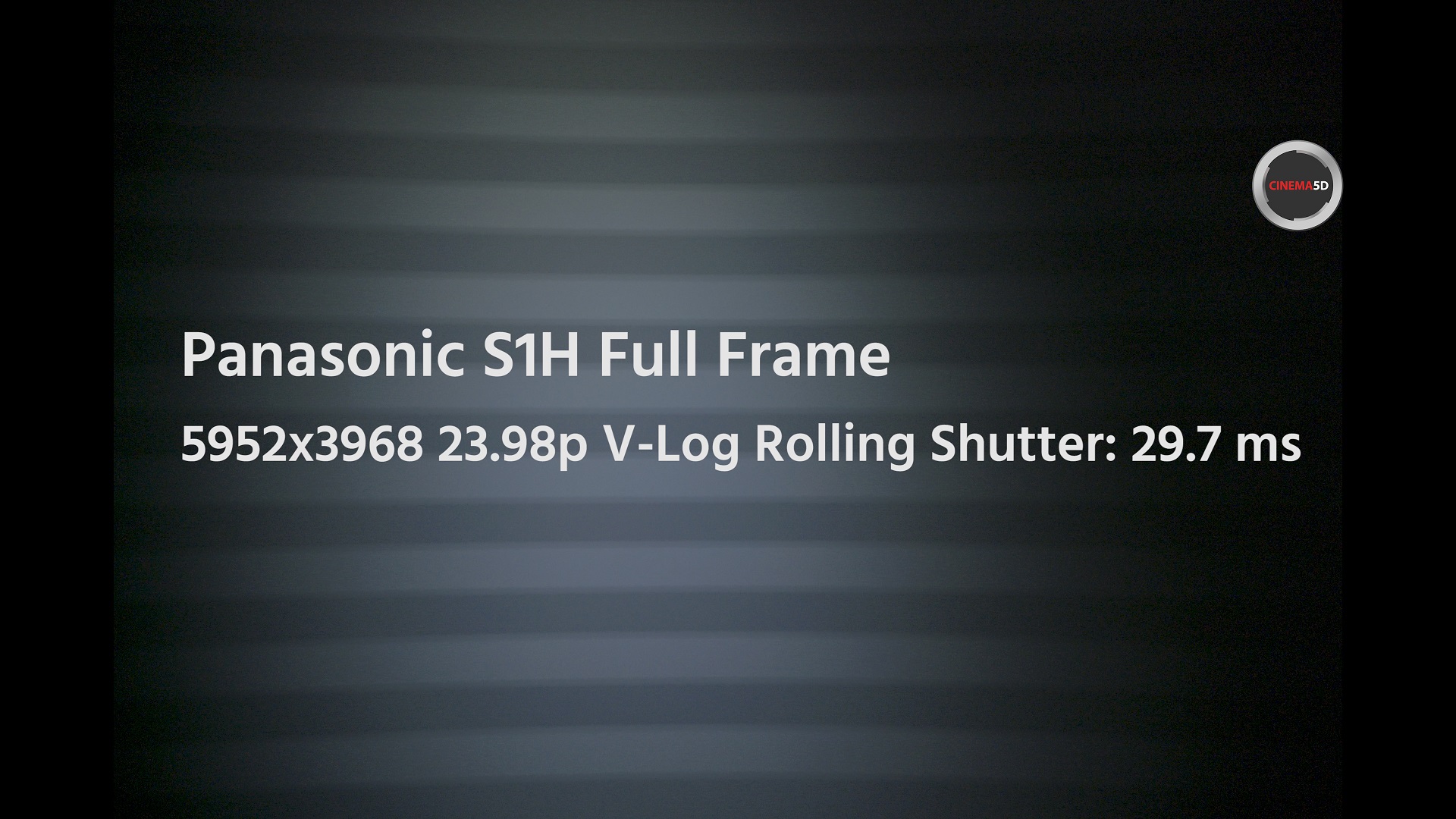
A rolling shutter of 29.7 [ms] is measured for the Panasonic S1H in 6K full frame 3:2 mode at 23.98 fps.
The situation improves slightly at full frame 4K DCI settings. A rolling shutter of 24.2 [ms] is measured, see the result below.
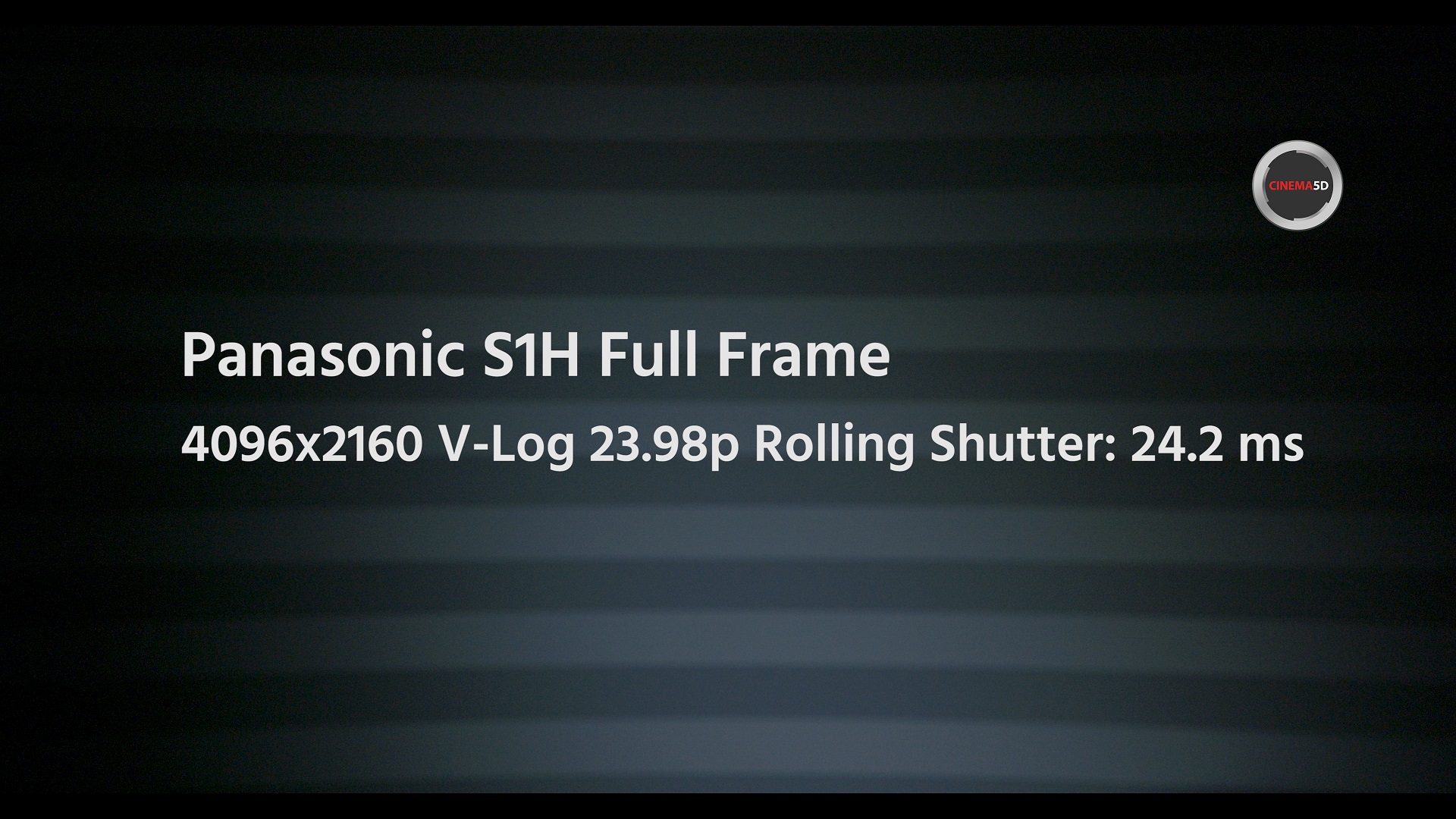
A rolling shutter of 24.2 [ms] is measured for the Panasonic S1H in 4K DCI full frame mode at 23.98 fps.
In the Super 35 mode, a result of 13.9 [ms] is achieved for 4K DCI 23.98 as well as 59.94 fps. This now is a good result – but again the Panasonic S1 was better at 10.4 [ms] at 25 fps.
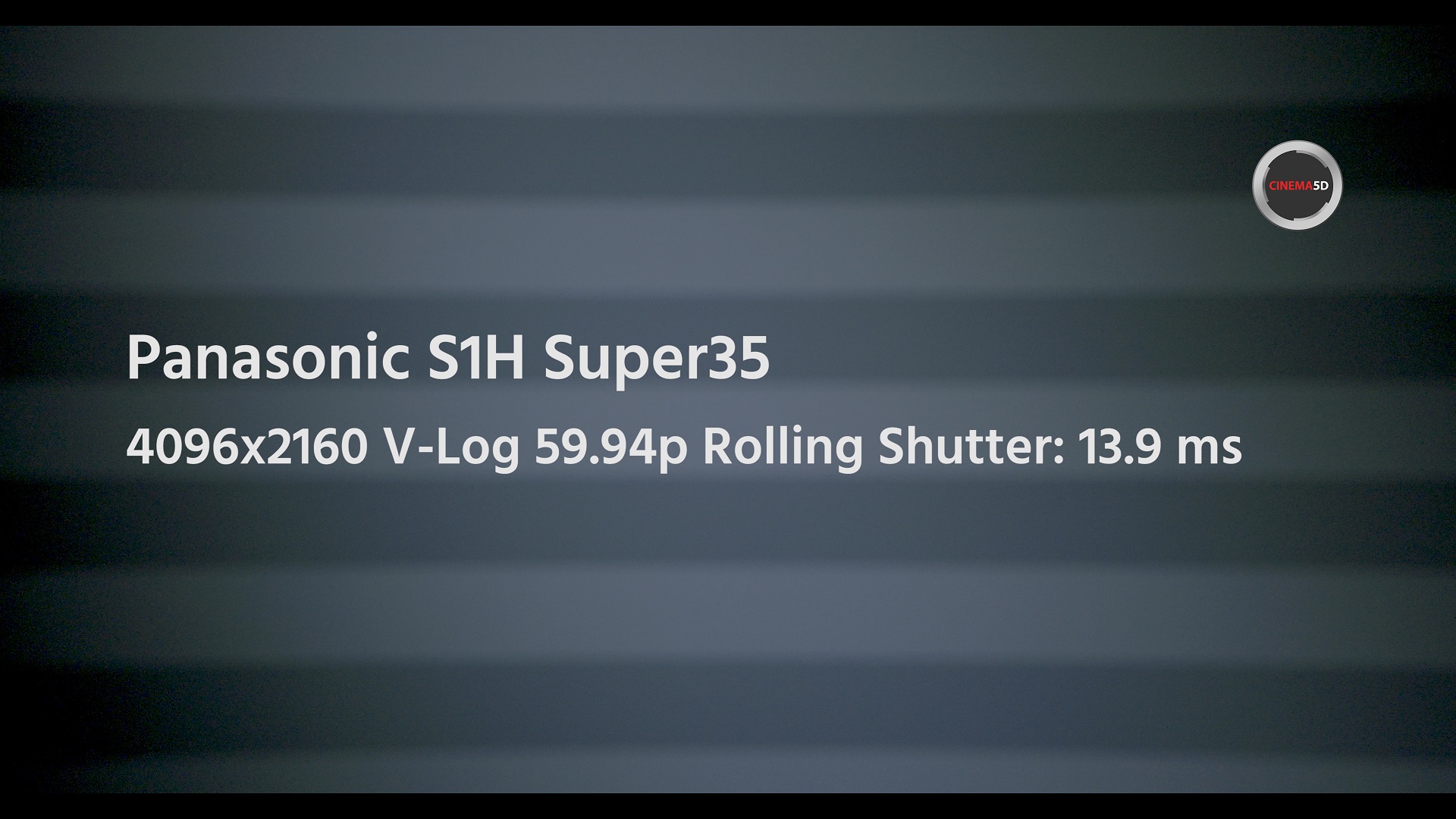
A rolling shutter of 13.9 [ms] is measured for the Panasonic S1H in 4K DCI Super 35 mode at 59.94 fps.
Summary of Test Results for the Panasonic S1H
Wow, you made it until this point? Great, so here is my summary table for all the different modes and ISO’s.
All in all, I am impressed – the dynamic range results are exceptional. Panasonic claims this cam to be a 14+ stops camera, which is close to the signal to noise ratio = 1 result (13.8 stops) – as mentioned earlier we are a little more strict here and use the SNR = 2 result of 12.7 stops as the official cinema5D rating (following ARRI’s logic).
Furthermore, the fact that the dual gain sensor shows very similar dynamic range results (in 4K DCI) at both ISO640 and ISO4000 settings is phenomenal. You can use the higher ISO without any impact on your final image.
However, where there is light you also find shadows: compared to the Panasonic S1, the rolling shutter in all modes is higher – in full frame depending on the fps setting around 13%, in Super 35 mode about 33%.
So, is the Panasonic S1H worth the 4000 USD versus the 2500USD Panasonic S1 (+200USD for the V-Log upgrade)? Certainly if you are looking for a Netflix certified camera (Full information can be found by clicking here and here). My colleague Johnnie might also help us with this decision. His Panasonic S1H review and the short documentary he made as part of this review are now online and can be watched by clicking here.
And yes, I have not decided on this subject myself either…
Are you considering the Panasonic S1H as your next full frame camera? Let us know in the comments below.
